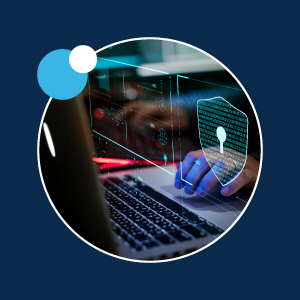In the past, new technology solutions required highly experienced developers to compile certain coding languages, understand specific technologies and utilize specialized software. On top of these challenges, traditional development platforms limited innovation. Now, organizations have a new and improved development option, which can reduce time and costs while increasing customizability, automation and growth, known as low-code platforms.
Low-code can be implemented in various ways, but in the cybersecurity realm, it is often used to automate and streamline processes, such as cybersecurity operations. Low-code platforms allow digital teams to access capabilities and customizable technologies and tools that empower them to quickly produce valuable innovations, applications, and solutions with little to no limitations. Gartner predicts that 70% of new applications will use low-code or no-code technologies by 2025. As a result, application development will shift to allow teams to focus more on assembly and integration rather than development, resulting in improved efficiency, enhanced employee satisfaction and increased productivity.
For the Department of Defense (DoD) cybersecurity professionals, low-code presents an array of benefits and challenges. While it creates agility, simplification and innovation, low-code can also introduce cybersecurity risks and vulnerabilities.
Challenges of Low-Code in DoD Environments
When implementing any new process or platform, the DoD must pay attention to overall security and identify any potential risk factors that could infiltrate the environment. The DoD faces a unique challenge when considering low-code: supply chain management and ensuring the secure execution of low-code to avoid presenting new threats to its organization. For example, borrowing and leveraging unverified code from the internet can cause significant problems among an organization’s platforms. Copying and pasting code without testing it can lead to bugs, errors and inaccuracies that can slow down and harm an environment, creating further security issues.
 For cybersecurity and zero trust professionals within the industry, this idea of obtaining and launching bad content is particularly challenging as they strive to protect their organization’s operations. These groups must also be prepared to identify insider threat and guarantee security when utilizing a truly limitless customization of content like low-code. Organizations must ensure new code is protected yet unrestricted. Otherwise, they run the risk of negating the purpose of a low-code platform. Ultimately, the sources and employees creating and executing new low-code must be trusted entities to avoid problems like data leaks, exploitation and cyber-attacks.
For cybersecurity and zero trust professionals within the industry, this idea of obtaining and launching bad content is particularly challenging as they strive to protect their organization’s operations. These groups must also be prepared to identify insider threat and guarantee security when utilizing a truly limitless customization of content like low-code. Organizations must ensure new code is protected yet unrestricted. Otherwise, they run the risk of negating the purpose of a low-code platform. Ultimately, the sources and employees creating and executing new low-code must be trusted entities to avoid problems like data leaks, exploitation and cyber-attacks.
Benefits of Low-Code in Cybersecurity
While there are clear risks, the benefits to using low-code solutions continue to make it a desirable cybersecurity option. It offers the flexibility to stay ahead of emerging threats, while simultaneously saving on costs. Ultimately, low-code development enables organizations to keep pace with an ever-changing security landscape.
- Respond immediately to emerging threats: Local platforms help an organization to become more agile. Customized low-code content enables organizations to respond quickly when existing security tools may not be able to support the software system and prevent or stop a threat.
- Quickly create custom features: The flexibility of low-code within local platforms allows for the creation of features to match the immediate needs of an organization instead of waiting for the release of the latest software which may or may not solve the problem. The progression of low-code implementation increases the longevity and growth of an organization.
- Build upon low-code and local platforms to save on costs: A low-code solution along with the implementation of a local platform should be able to fulfill multiple use cases and eliminate various other tools from an organization’s toolbox. Once a local platform is implemented, limitations can be lifted and advancements or replacements can be made to older legacy systems instead of purchasing multiple new tools. This saves costs for security and asset management teams.
Eliminating Risk in Low-Code Capabilities in Cybersecurity Today
The good news for cybersecurity organizations is that they can easily mitigate low-code risks and challenges with proper access controls and a simple deployment process. Any new code created for government customers or internal purposes should undergo rigorous and reliable testing through multiple levels of technical experts within an organization to ensure quality, validity and trustworthiness. Additionally, testing in a simulation of the customer’s intended environment for that code should only be a matter of minutes, ensuring a smooth production process once the code has been executed.
If purchasing a low-code solution from a third-party vendor, organizations should investigate their internal code reviews, Quality Assurance testing and delivery methods to ensure strict standards are being met. Features such as signed content, restricted third party binary executions, and more help ensure an organization can take advantage of the numerous benefits of a low-code platform without introducing risk and vulnerabilities.
The Future of Low-Code
Today’s advanced artificial intelligence-driven technology, combined with natural language processing, enables everyday employees to create complex code by simply asking a question. The local community base within organizations now has the power to heighten efficiency, productivity and creation for their deployments with quicker, more customized low-code content. Low-code and local platform capabilities provide the freedom to create innovative solutions facilitating the growth of their business.
Learn more about secure, low-code cybersecurity solutions like TYCHON at tychon.io.








